How Do Board Games Go Viral?

Pandemic Legacy: Season 1 (Photo: yoppy/flickr)
Codenames is a simple game. There are 25 small cards, each with a word on it, and two teams are trying to guess, based on one-word hints, which eight or nine of those words belong to them. There’s not even a board; the game should cost $20. But over Christmas, demand was so high that, with stores out of stock, copies on Amazon were going at an incredible mark-up, for $50.
Vlaada Chvátil, a game designer who is famous enough for fans to try his new game on faith. Soon it became the highest-ranked party game on Board Game Geek, an online spot for game enthusiasts. The site has reviews and rankings, like Yelp, but also discussion boards, like Reddit. And as with Reddit, something that’s madly popular on Board Game Geek can break through to a wider audience and go viral—Codenames got picked up by sites like Geek Dad, Ars Technica, Popular Mechanics and more. Kentucky Sports Radio named it “party game of the year.”
But why so much hype over, essentially, a few sets of cards?
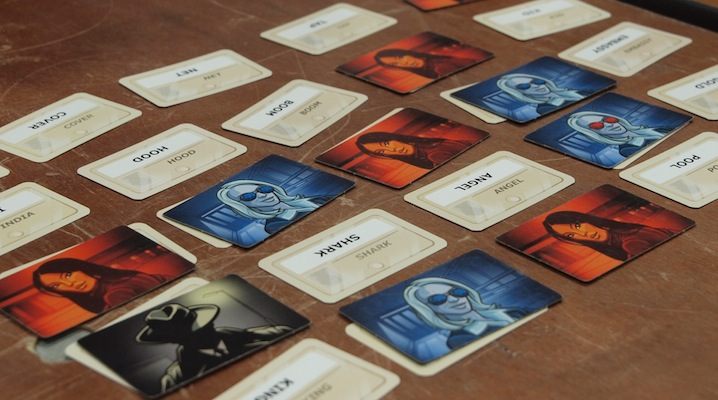
Codenames (Photo: JIP/Wikimedia)
The current popularity of board games–call it a golden age, call it a renaissance–is usually traced back to Settlers of Catan, which is now two decades old and so popular that, like Madonna or Adele, it has achieved one-name-level fame and been rebranded as, simply, Catan. But year after year, the market for board games and other tabletop games (card games, dice games, role-playing games) keeps growing. In 2013, total retail sales of hobby games hit $700 million, and the next year topped $880 million. In 2015, more than twice as many people backed tabletop games on Kickstarter as in 2014, and they pledged two-thirds more money, almost $89 million altogether.
This boom is not just about European designers making great games and American audiences slowly discovering them. Online companies and gadget makers are constantly promising to bring people closer together; by their very nature, board games actually do that, and even with flocks of app-based games demanding attention, cardboard-based games are thriving. Gamers are a fairly small community with an intense interest in a somewhat obscure pursuit–exactly the sort of group enabled by the internet. Board games, designed in Europe, America, and Asia, too, are now moving at internet speed, so that where new games used to get popular ever so slowly, now, boom!, it’s possible for Exploding Kittens to blow up everywhere all at once.
The Not-Famous Famous Game Designer

Catan (Photo: dograapps/pixabay)
Early on in the 20th century, there was a wave of board game creativity, followed by a massive mid-20th century consolidation of American gaming companies. For a long time, game sales have depended on name-brand recognition, creating ever-expanding franchises. That’s how we’ve been blessed with Monopoly Empire edition, Monopoly Spongebob Squarepants, Monopoly Star Wars, Monopoly Rhode Island, Monopoly Junior, and so many other editions of Monopoly, despite the suspicion among gamers and designers that few people actually like playing Monopoly.
Newer games use this same trick: there’s also a Star Trek Catan. But now it’s possible for marquee designers to strike out on their own and sell games based in part on their own personal brand.
As even the most successful and high profile game designers will admit, there’s no such thing as an actually famous game designer. Possibly, possibly, if you are a fan of Catan, you know that its designer is Klaus Teuber. In the past, even designers with hit games often pursued their game design as a side job or a passion project; now they can sometimes make games their full-time job.
“It’s a really great time to be a not-famous game designer,” says Mike Selinker, a game designer and president of Lone Shark Games. His company made the Pathfinder Adventure Card Game in 2013, kind of a big deal in certain circles.
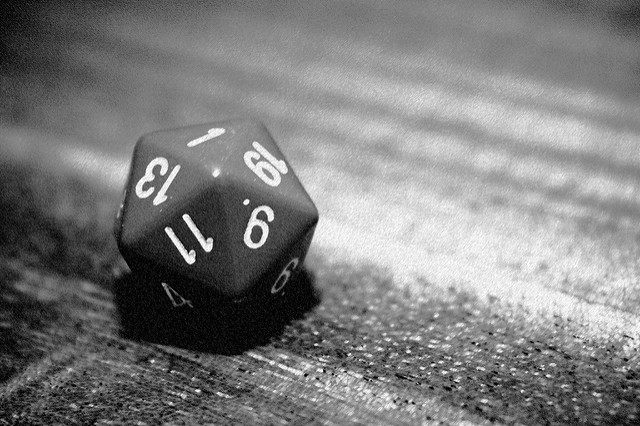
20-sided die (Photo: Scott Ogle/flickr)
These designers can thrive both because game sales are up and because sites like Board Game Geek (and Reddit where there’s a thriving board games subreddit) have created a community that can amplify their work. New games get passed around at the big gaming conventions; early reviews go out online, and gamers start anticipating their release.
There’s also an infrastructure of online tastemakers, most prominently Tabletop, a web show where Wil Wheaton (who played Wesley Crusher on Star Trek: The Next Generation) and a crew play through new and exciting games. If the show gives a positive review, people will go out and buy it. There’s even supposed to be a “Wil Wheaton” effect–a noticeable bump in sales after Tabletop reviews a game.
The Means of Production

Cards Against Humanity (Photo: brett jordan/flickr)
At the same time, control of the means of production for games has shifted. When European board games started getting popular in the U.S., it clued in game designers that maybe they didn’t need a giant company like Hasbro to survive. With consumer design tools and access to Chinese manufacturing, maybe they didn’t need to work with a company at all.
Kickstarter might have been made for game designers. Last year on the site, the Games category was the largest in terms of “total” and “successful” dollars. That includes video games, which tend to be more expensive, but also tabletop game projects that had millions of dollars pledged to them. The funding threshold for a tabletop game is also relatively low, compared to demand. It’s not uncommon to see a games project at 300 percent of its original funding goal, and some of them raise exponentially more money than they needed to go forward, and end with more than 1,000 percent more money than they asked for.
Cards Against Humanity is perhaps the poster child for games born from the internet. The group of friends who designed the game did not even try selling it to a traditional publisher. But they did need start-up capital. “We needed $4,000 to do the first printing, and it seemed like an impossible amount of money,” says Max Temkin, one of the game’s co-creators. “When we started working on games, we didn’t know anyone who had that much.”
The game’s Kickstarter campaign, in 2012, raised more than three times that–$15,570. It was a huge success. But that campaign seems incredibly modest compared to the breakout game on Kickstarter in 2015, Exploding Kittens, a simple card game in which players try to avoid drawing a card with an exploding kitten on it.
Exploding Kittens also had a relatively modest goal, of $10,000. It raised $8,782,571, and was the year’s most popular project, measured in the number of people contributing.
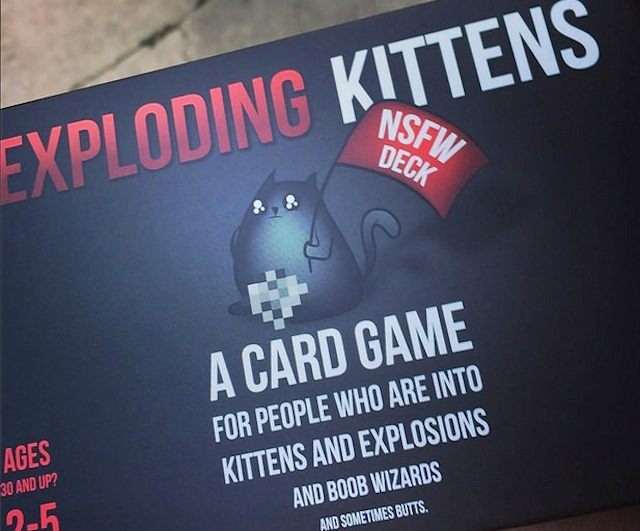
Exploding Kittens (Photo: Michael Brown/flickr)
Exploding Kittens had one particular advantage. Its art was done by Matthew Inman, the popular online cartoonist of the Oatmeal. When Toy & Game Con asked the game’s designer, Elan Lee, why it went viral, he said, “The easy answer to that is The Oatmeal. Matt has such a huge following, that simply posting to his social media accounts was the entirety of our initial marketing plan.”
That wasn’t entirely the end of the story: the team also promoted the game through live events and another big marketing push. But art–how a game looks–does seem to matter more than ever before.
That’s just one way in which designers have had to work harder for attention. “Your game has to get people in ways that it didn’t before,” says Selinker. The speed at which the industry now moves, he says, “has upped the pressure on game designers to be really innovative, all the time.”
Co-ops

Dice are still in style (Photo: Wikimedia)
America has gone through a few waves of insurgent gaming trends. In the 1980s, role-playing games started rolling out of the Midwest; in the 1990s, trading cards games, led by Magic the Gathering and Pokemon, took over. By the 2000s, Catan and its Euro-style clan were sweeping in.
The speed and growth of the game industry is incubating some new trends, although it’s not clear yet which might stick. Some games purposefully limit communication. It’s become more common, too, to have game incorporate a physical skill–you might fight a monster by flicking tokens at it, instead of rolling a die. The most lasting trend, though, might be games with a co-operative element, where players work together to “beat the board” rather than to best each other.
One of the most popular examples of a co-op game is Pandemic, in which players work together to stop the spread of viruses across the globe. It was first released in 2008, and since then, its creator, Matt Leacock, started noticing more and more games that had at least some co-operative element to them. He decided to gather data on Board Game Geek, “just to see, you know, is this an imagined effect or it is real?” And, he found, it was very real. When he look at the percentage of games that had a co-operative element, year-over-year, there was a growing trend starting in 2009. (He explains all the details here.) “It’s pretty dramatic,” he says.
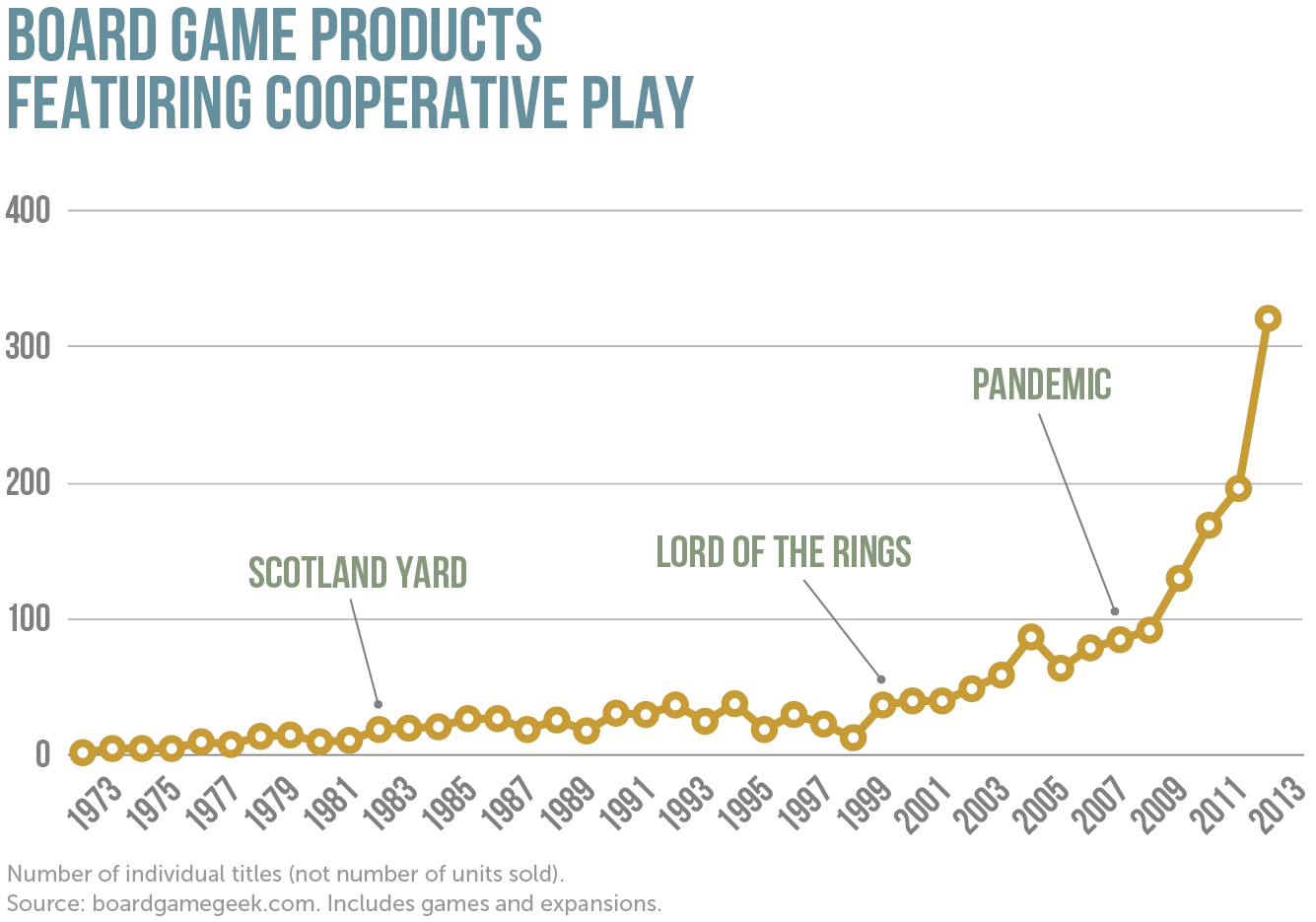
(Data: Matt Leacock/Design: Blake Olmstead)
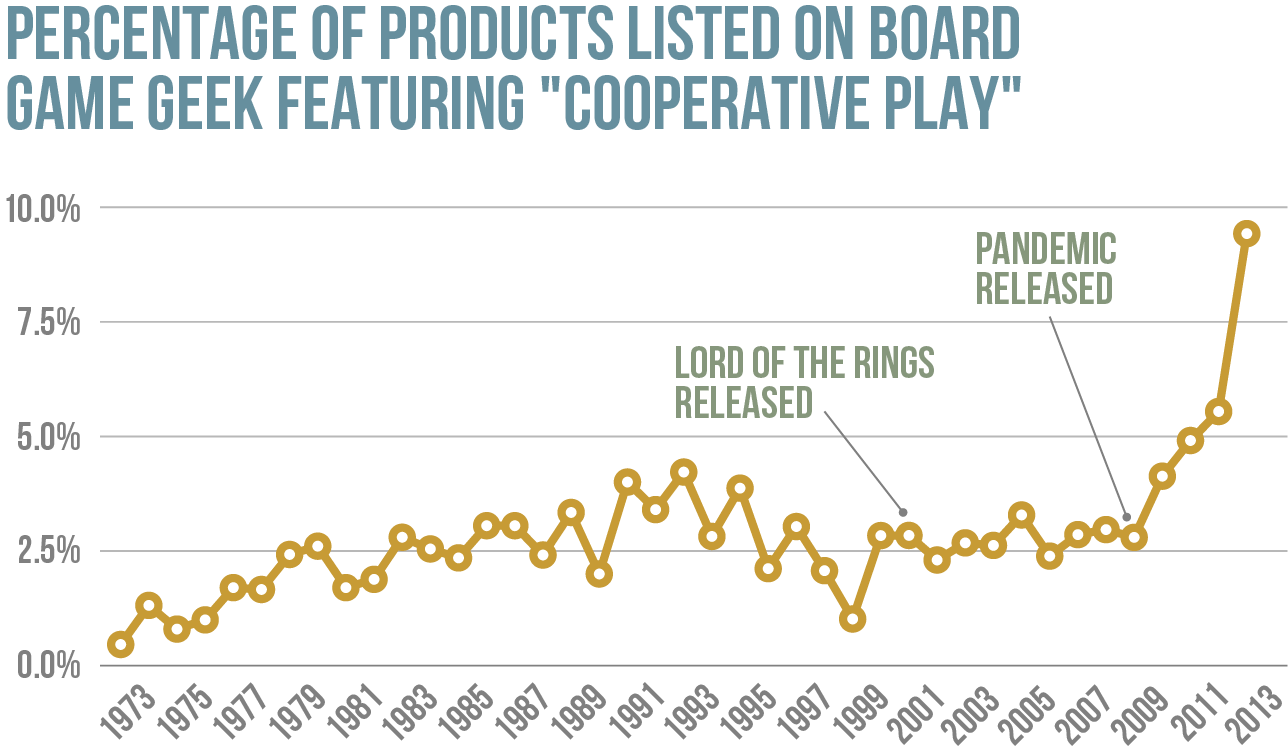
(Data: Matt Leacock/Design: Blake Olmstead)
Pandemic itself, though, is also mutating. Leacock partnered with another designer, Rob Daviau, to create a version of the game called Pandemic Legacy: Season 1, in which the game changes as it’s played
Daviau and Leacock come from somewhat different places in the gaming world. “We’re on opposite ends of the spectrum…well, not quite on opposite ends,” says Daviau. “We both have leanings,” says Leacock. “I tend to be a little more on the Euro, cleaner, tighter style. Rob excels at story.” (Storytelling is often associated with role-playing games.) Daviau worked at Hasbro for 14 years, before recently going independent; Leacock designed games on the side before the success of Pandemic meant he could make this his job. They didn’t meet before they began working on this game together.
Pandemic Legacy is both a Euro-style game and a very American one. Before leaving Hasbro, Daviau had designed a new type of game, based on a very old one. It was called Risk Legacy, and unlike in old-fashioned Risk, each game had consequences for the next. Over 15 rounds of the game, winners get bonuses, choices can’t be undone, cards get ripped up or otherwise destroyed, the game board is permanently modified. Pandemic Legacy takes this same idea and marries it to Pandemic. In this game, there are 12 “months,” each representing a round of the game. As players progress through the game, the viruses they’re fighting change, funding gets higher or lower, and characters gain new skills, or limitations, or even are eliminated altogether.
Working on the games, “it began to feel like we were writing a TV season, really,” says Leacock. That’s where the full name, “Season 1,” came from. (There’s already a Season 2 in development.)
Some gamers fiercely oppose legacy games, because they require changing or destroying some parts of the game. But others love them. If Pandemic Legacy hasn’t exactly gone viral yet, wait: in January, it became the #1 ranked board game on Board Game Geek.







Follow us on Twitter to get the latest on the world's hidden wonders.
Like us on Facebook to get the latest on the world's hidden wonders.
Follow us on Twitter Like us on Facebook